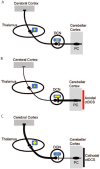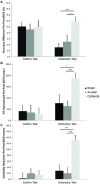Cerebellar Transcranial Direct Current Stimulation (ctDCS): A Novel Approach to Understanding Cerebellar Function in Health and Disease
- PMID: 25406224
- PMCID: PMC4712385
- DOI: 10.1177/1073858414559409
Cerebellar Transcranial Direct Current Stimulation (ctDCS): A Novel Approach to Understanding Cerebellar Function in Health and Disease
Abstract
The cerebellum is critical for both motor and cognitive control. Dysfunction of the cerebellum is a component of multiple neurological disorders. In recent years, interventions have been developed that aim to excite or inhibit the activity and function of the human cerebellum. Transcranial direct current stimulation of the cerebellum (ctDCS) promises to be a powerful tool for the modulation of cerebellar excitability. This technique has gained popularity in recent years as it can be used to investigate human cerebellar function, is easily delivered, is well tolerated, and has not shown serious adverse effects. Importantly, the ability of ctDCS to modify behavior makes it an interesting approach with a potential therapeutic role for neurological patients. Through both electrical and non-electrical effects (vascular, metabolic) ctDCS is thought to modify the activity of the cerebellum and alter the output from cerebellar nuclei. Physiological studies have shown a polarity-specific effect on the modulation of cerebellar-motor cortex connectivity, likely via cerebellar-thalamocortical pathways. Modeling studies that have assessed commonly used electrode montages have shown that the ctDCS-generated electric field reaches the human cerebellum with little diffusion to neighboring structures. The posterior and inferior parts of the cerebellum (i.e., lobules VI-VIII) seem particularly susceptible to modulation by ctDCS. Numerous studies have shown to date that ctDCS can modulate motor learning, and affect cognitive and emotional processes. Importantly, this intervention has a good safety profile; similar to when applied over cerebral areas. Thus, investigations have begun exploring ctDCS as a viable intervention for patients with neurological conditions.
Keywords: cerebellum; cognitive; ctDCS; direct current stimulation; emotion; language; learning; modeling; motor; plasticity; safety; transcranial; working memory.
© The Author(s) 2014.
Conflict of interest statement
Figures






References
-
- Baddeley AD. 1986. Working memory. Oxford, England: Clarendon Press.
-
- Boehringer A, Macher K, Dukart J, Villringer A, Pleger B. 2013. Cerebellar transcranial direct current stimulation modulates verbal working memory. Brain Stimul 6:649–53. - PubMed
Publication types
MeSH terms
Grants and funding
LinkOut - more resources
Full Text Sources
Other Literature Sources

